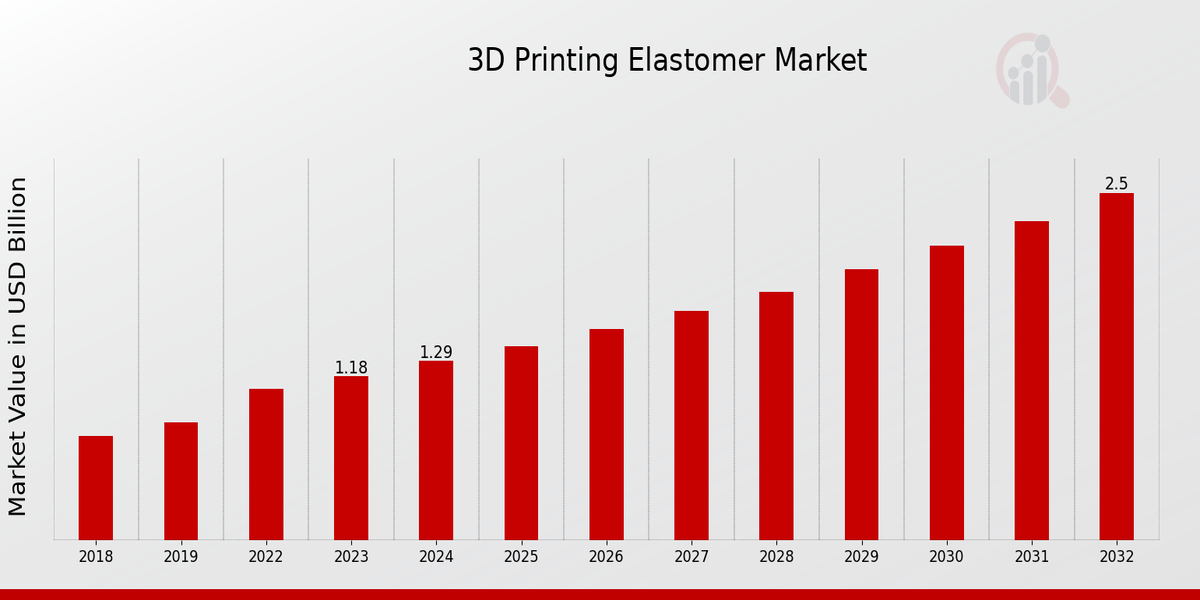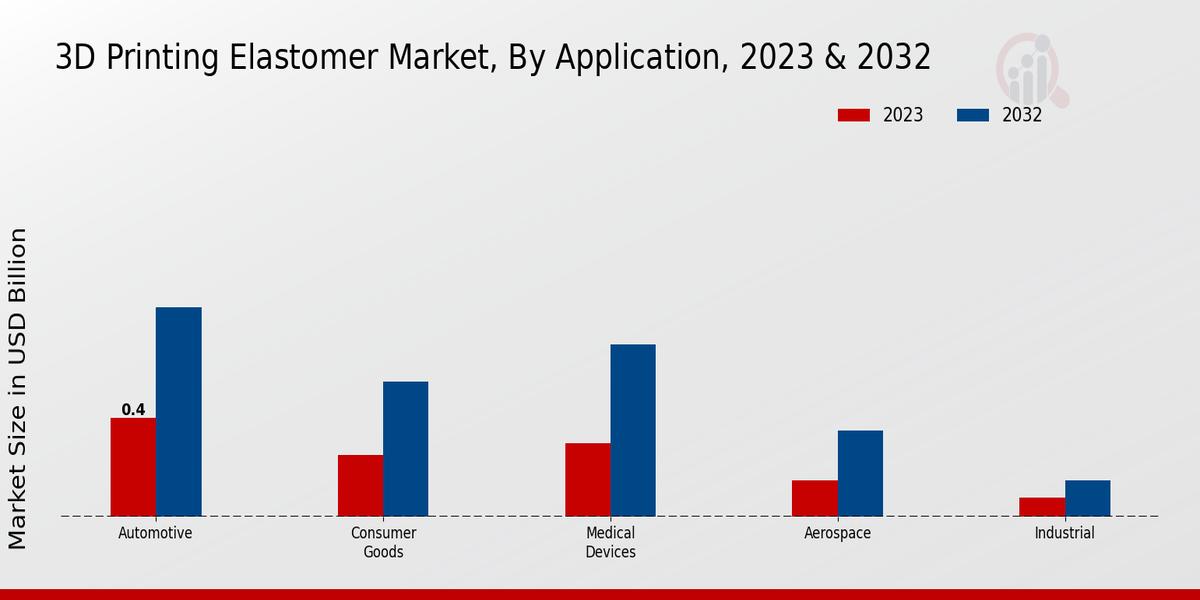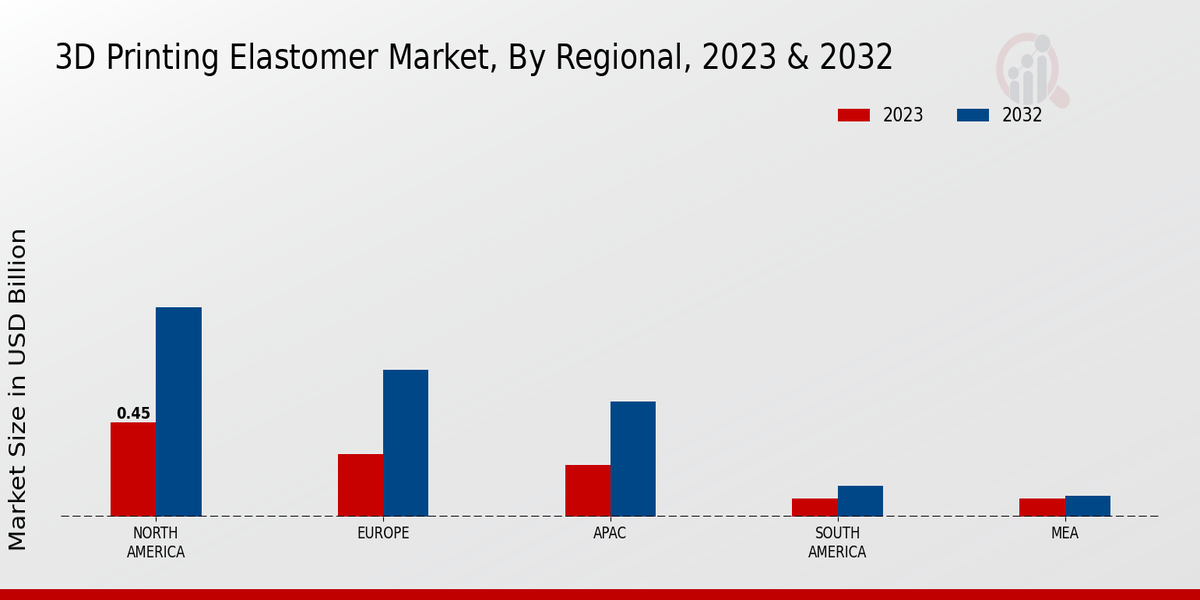Global 3D Printing Elastomer Market Overview
The 3D Printing Elastomer Market Size was estimated at 1.4 (USD Billion) in 2024. The 3D Printing Elastomer Industry is expected to grow from 1.52(USD Billion) in 2025 to 3.21(USD Billion) by 2034. The 3D Printing Elastomer Market CAGR (growth rate) is expected to be around 8.70% during the forecast period (2025 - 2034).
Key 3D Printing Elastomer Market Trends Highlighted
The 3D Printing Elastomer Market is witnessing significant growth due to several key drivers. The increasing demand for customized products across various sectors, such as healthcare, automotive, and consumer goods, is propelling the adoption of 3D printing technologies. In addition, the rising awareness regarding sustainability is encouraging industries to switch from traditional manufacturing methods to more efficient and eco-friendly alternatives. The flexibility and versatility of elastomers in 3D printing also enhance their appeal, allowing manufacturers to produce intricate designs and functional prototypes with ease. Technological advancements in materials and printing techniques contribute further to market expansion, facilitating better performance and enhancing the properties of elastomer products.There are ample opportunities to be explored in the 3D Printing Elastomer Market. As companies continue to invest in research and development, novel materials with improved properties are being introduced, which can enhance applications in various industries. The emerging trend of integrating 3D printing technologies with automation and digital manufacturing presents a significant opportunity for companies to streamline production processes and reduce costs. Additionally, collaborations between material suppliers and technology providers can lead to innovative solutions tailored to specific industry needs. Companies that focus on creating applications for specific market segments are likely to establish a competitive edge.Recent trends in the 3D Printing Elastomer Market indicate a shift towards more specialized applications. Industries are increasingly using elastomers for prototyping in complex shapes and functional components, which were previously difficult to achieve using conventional methods. The advent of advanced 3D printing technologies, such as Binder Jetting and Digital Light Processing, is expanding the spectrum of elastomer applications. Moreover, end-users are seeking not just functional products but also aesthetically pleasing designs, prompting manufacturers to focus on improving the visual attributes of printed elastomers. As the technology continues to progress, it is expected that the market will evolve, showcasing innovative materials and applications that will further drive growth.

Source: Primary Research, Secondary Research, MRFR Database and Analyst Review
3D Printing Elastomer Market Drivers
Advancements in 3D Printing Technology
The advancements in 3D printing technology have significantly propelled the 3D Printing Elastomer Market Industry. Over the past few years, innovations such as enhanced printer speed, improved material quality, and sophisticated software solutions have transformed the capabilities of 3D printing. This technology allows for the creation of complex geometries and intricate designs that were previously unattainable with traditional manufacturing methods.Such capabilities are particularly valuable in industries that require customized solutions, such as medical devices, automotive parts, and consumer products. As the technology continues to evolve, manufacturers are increasingly adopting 3D printing for rapid prototyping and production, leading to greater efficiency and reduced lead times. The reduction in material waste associated with additive manufacturing also plays a pivotal role in favoring the adoption of 3D printing elastomers.Furthermore, the rise of Industry 4.0 and smart manufacturing processes integrates 3D printing with automation, the Internet of Things (IoT), and data analytics, enhancing operational productivity. This technological evolution not only boosts the market growth but also provides the foundation for future innovations and developments within the 3D Printing Elastomer Market.
Growing Demand for Customization
The demand for customization across various industries is a key driver in the growth of the 3D Printing Elastomer Market Industry. As consumers increasingly favor products tailored to their individual needs and preferences, manufacturers are leveraging 3D printing to fulfill these requirements. The ability to create bespoke items, from personalized medical implants to custom footwear, showcases the unique advantage of 3D elastomers. This shift towards personalization is further supported by advancements in design software that allow rapid modifications and iterations, thereby meeting customer expectations swiftly.
Sustainability and Eco-Friendly Solutions
Sustainability concerns are becoming more prominent, driving the adoption of eco-friendly manufacturing processes. The 3D Printing Elastomer Market Industry benefits from this movement as 3D printing typically generates less waste compared to traditional manufacturing. Innovations in biodegradable elastomer materials are also gaining traction, appealing to environmentally conscious consumers and businesses. As companies strive to enhance their sustainability profiles, embracing 3D printing technologies aligns with their goals while also attracting a broader customer base.
3D Printing Elastomer Market Segment Insights
3D Printing Elastomer Market Application Insights
The 3D Printing Elastomer Market has shown strong growth potential across various applications, highlighted by a complete market valuation of 1.18 USD Billion in 2023. The application of 3D printing elastomers spans several key sectors with varying degrees of market significance. The automotive sector, valued at 0.4 USD Billion, holds a substantial position within this market, projected to increase to 0.85 USD Billion by 2032, demonstrating its crucial role in manufacturing lightweight and customizable components that enhance vehicle performance and efficiency.In the consumer goods sector, the value of 0.25 USD Billion in 2023 is expected to grow to 0.55 USD Billion in 2032, showcasing a rising demand for personalized and innovative products. The medical devices application is another significant contributor, currently assessed at 0.3 USD Billion and anticipating growth to 0.7 USD Billion, emphasizing the need for tailored solutions that cater to individual patient needs. The aerospace sector, although smaller, exhibits notable potential, progressing from a valuation of 0.15 USD Billion in 2023 to 0.35 USD Billion by 2032, as it seeks to adopt advanced materials for weight reduction and enhanced design flexibility in aircraft manufacturing.The industrial application is projected to grow from 0.08 USD Billion in 2023 to 0.15 USD Billion by 2032, supported by the increasing adoption of 3D printing technologies to improve production efficiency and reduce waste. Each of these sectors contributes uniquely to the overall revenue of the 3D Printing Elastomer Market, driven by trends such as customization, efficiency, and advanced material applications while facing challenges such as regulatory hurdles and material compatibility that continue to shape market growth dynamics. The 3D Printing Elastomer Market segmentation reflects a broad interest in exploring innovative solutions across diverse industries, ensuring the market’s resilience against potential disruptions.

Source: Primary Research, Secondary Research, MRFR Database and Analyst Review
3D Printing Elastomer Market Type Insights
The 3D Printing Elastomer Market, valued at 1.18 billion USD in 2023, showcases significant segmentation in its Type category, including Thermoplastic Elastomers, Thermosetting Elastomers, and Silicone Elastomers. Each of these categories plays a crucial role, with Thermoplastic Elastomers often dominating the market due to their flexibility and ease of processing, making them widely adopted in various industries. Meanwhile, Thermosetting Elastomers provide durability and heat resistance, catering to more specialized applications where performance is paramount.Silicone Elastomers hold their own significance, particularly in medical and automotive applications, valued for their excellent thermal stability and biocompatibility. The ongoing innovations in printing techniques and materials are driving growth in the 3D Printing Elastomer Market. These advancements present opportunities, while challenges such as material cost and limited scalability remain. The expected market growth for the period from 2024 to 2032 is expected to highlight these segments' adaptability, potentially reshaping their impact on the overall market landscape and emphasizing the importance of developing high-performance elastomers.
3D Printing Elastomer Market Process Technology Insights
The 3D Printing Elastomer Market revenue is expected to reach 1.18 billion USD in 2023, showcasing a significant interest in advanced manufacturing technologies. The Process Technology segment plays a crucial role in this growth, as it encompasses different methodologies that enhance material performance and production efficiency. Among these methodologies, Fused Deposition Modeling is recognized for its flexibility and ease of use, making it a preferred choice for many manufacturers. Selective Laser Sintering contributes by enabling the creation of complex geometries and is notable for its ability to process a variety of elastomer materials.Meanwhile, Stereolithography is significant due to its rapid prototyping capabilities, allowing for faster development cycles in product design. The combination of these techniques provides diverse opportunities within the 3D Printing Elastomer Market segmentation, responding to the growing demand for customized parts and products across multiple industries. Market growth is further aided by increasing adoption in automotive, healthcare, and consumer goods, which require lightweight and durable components. However, challenges such as material costs and production scalability need to be addressed to maximize market potential.Overall, the Process Technology segment stands as a foundational element driving advancements in the 3D Printing Elastomer Market industry.
3D Printing Elastomer Market End Use Industry Insights
The 3D Printing Elastomer Market has shown significant potential within the End Use Industry, expected to be valued at 1.18 billion USD in 2023. This market is primarily driven by diverse sectors, including Healthcare, Electronics, Consumer Products, Robotics, and Mold Making. Each of these sectors leverages 3D printing elastomers for their unique applications, significantly enhancing product designs and functionalities. Healthcare stands out for its importance, as it enables the production of customized prosthetics and medical devices, addressing specific patient needs.The Electronics segment has gained traction due to the demand for lightweight and flexible components, which are critical in modern electronic devices. Consumer Products make extensive use of elastomers to create innovative designs and improve user experience, showcasing the versatility of 3D printing technology. Robotics has also become a considerable player, utilizing elastomers to create lightweight robotic parts that enhance performance. Mold Making remains significant, as 3D printed elastomers offer efficiency in producing complex molds that traditional methods may struggle with.The evolving applications across these sectors underscore the importance of the 3D Printing Elastomer Market, reflecting ongoing market growth driven by innovation and the increasing demand for customized solutions.
3D Printing Elastomer Market Regional Insights
The 3D Printing Elastomer Market is expected to be valued at 1.18 USD Billion in 2023, reflecting significant regional variations in market performance. North America holds a majority share, valued at 0.45 USD Billion in 2023, and is projected to rise to 1.0 USD Billion by 2032, highlighting its dominance in the industry due to robust demand across various applications. Europe follows closely, with a valuation of 0.3 USD Billion in 2023, likely growing to 0.7 USD Billion by 2032, benefiting from advanced manufacturing capabilities and innovation.The APAC region, currently at 0.25 USD Billion in 2023, is anticipated to reach 0.55 USD Billion by 2032, driven by increasing adoption of 3D printing technologies in various industries. Meanwhile, South America and MEA represent the smallest segments, valued at 0.09 and 0.09 USD Billion in 2023, respectively, indicating emerging market potential and developing infrastructure. The regional dynamics in the 3D Printing Elastomer Market showcase varying growth drivers, challenges, and opportunities, ultimately shaping the industry landscape and influencing investment strategies.

Source: Primary Research, Secondary Research, MRFR Database and Analyst Review
3D Printing Elastomer Market Key Players and Competitive Insights
The 3D Printing Elastomer Market is witnessing significant growth fueled by advancements in additive manufacturing technologies and the increasing demand for custom, flexible materials. As this market evolves, various players are leveraging their technical expertise and innovation capabilities to enhance product offerings and carve out competitive advantages. The market's dynamics are shaped by a blend of established companies and emerging players, all striving to meet the diverse requirements of industries such as automotive, healthcare, and consumer goods. Analyzing competitive insights reveals how these companies are positioning themselves to capture market share, respond to trends, and develop strategic partnerships that can further their growth in this rapidly changing landscape.Carbon stands out in the 3D Printing Elastomer Market due to its pioneering Continuous Liquid Interface Production technology, which enables rapid prototyping and production of high-quality elastomeric parts. The company’s unique approach to material science allows it to create flexible, durable, and high-performance materials that are particularly well-suited for applications requiring resilience and versatility. Carbon's strong brand reputation is further bolstered by its commitment to innovation and an agile development process, allowing it to respond quickly to shifts in consumer demand. Their robust ecosystem of hardware, software, and materials enhances user experience and facilitates seamless integration across industries. Carbon's dedication to sustainability and reducing waste in the manufacturing process also positions it favorably among eco-conscious consumers, further solidifying its presence in the market.Stratasys is recognized as a key player in the 3D Printing Elastomer Market, known for its comprehensive range of advanced additive manufacturing solutions that include elastomeric materials. The company brings decades of experience in 3D printing technology, which empowers it to produce intricate designs and flexible parts that meet industry standards. Stratasys maintains a broad market presence through a strong distribution network and partnerships with various businesses, making it a go-to choice for manufacturers looking to utilize elastomers in their production processes. The launch of its innovative materials specifically designed for high performance and ease of use has elevated its status in the market. Stratasys also emphasizes customer support and education, fostering a community of users who maximize the benefits of their elastomeric material offerings. This customer-centric approach, combined with a commitment to cutting-edge research and development, strengthens Stratasys’ competitive position in the evolving 3D printing landscape.
Key Companies in the 3D Printing Elastomer Market Include
- Carbon
- Stratasys
- GE Additive
- Ricoh
- HP
- Nano Dimension
- Materialise
- 3D Systems
- Sculpteo
- Formlabs
- Prodways
- EOS
- Ultimaker
- ExOne
3D Printing Elastomer Market Industry Developments
Recent developments in the 3D Printing Elastomer Market have included significant technological advancements and collaborations among key players. Companies like Carbon, Stratasys, and GE Additive have been focusing on new material formulations that enhance the performance and adaptability of elastomers in various applications. HP and Materialise are expanding their portfolio with innovative 3D printing solutions that cater to increased demand from the automotive and healthcare sectors. Furthermore, the merger and acquisition landscape has seen activities such as smaller niche firms being acquired by larger entities like 3D Systems and Formlabs to strengthen their market position and expand their technological capabilities. This consolidation trend is impacting market dynamics, leading to enhanced product offerings and competitive pricing. Additionally, the valuation of companies in this sector is seeing upward growth, driven by rising demand for customized and efficient manufacturing processes, subsequently creating a more robust market landscape. The emphasis on sustainability and recycling of elastomers is also gaining traction as companies like Ultimaker and ExOne invest in eco-friendly materials and practices, which are increasingly becoming a focal point within the industry.
3D Printing Elastomer Market Segmentation Insights
3D Printing Elastomer Market Application Outlook
- Automotive
- Consumer Goods
- Medical Devices
- Aerospace
- Industrial
3D Printing Elastomer Market Type Outlook
- Thermoplastic Elastomers
- Thermosetting Elastomers
- Silicone Elastomers
3D Printing Elastomer Market Process Technology Outlook
- Fused Deposition Modeling
- Selective Laser Sintering
- Stereolithography
3D Printing Elastomer Market End Use Industry Outlook
- Healthcare
- Electronics
- Consumer Products
- Robotics
- Mold Making
3D Printing Elastomer Market Regional Outlook
- North America
- Europe
- South America
- Asia Pacific
- Middle East and Africa
| Report Attribute/Metric |
Details |
| Market Size 2024 |
1.4 (USD Billion) |
| Market Size 2025 |
1.52 (USD Billion) |
| Market Size 2034 |
3.21 (USD Billion) |
| Compound Annual Growth Rate (CAGR) |
8.670% (2025 - 2034) |
| Report Coverage |
Revenue Forecast, Competitive Landscape, Growth Factors, and Trends |
| Base Year |
2024 |
| Market Forecast Period |
2025 - 2034 |
| Historical Data |
2020 - 2024 |
| Market Forecast Units |
USD Billion |
| Key Companies Profiled |
Carbon, Stratasys, GE Additive, Ricoh, HP, Nano Dimension, Materialise, 3D Systems, Sculpteo, Formlabs, Prodways, EOS, Ultimaker, ExOne |
| Segments Covered |
Application, Type, Process Technology, End Use Industry, Regional |
| Key Market Opportunities |
Increased demand for customized products, Expanding automotive and aerospace applications, Innovations in biocompatible materials, Growth in the consumer electronics sector, Rising demand for eco-friendly solutions |
| Key Market Dynamics |
Increasing demand for flexible materials, Rapid technological advancements in printing, Expanding applications in various industries, Growing environmental sustainability initiatives, Rising investment in additive manufacturing technologies |
| Countries Covered |
North America, Europe, APAC, South America, MEA |
Frequently Asked Questions (FAQ) :
The 3D Printing Elastomer Market is expected to be valued at 3.21 billion USD in 2034.
The expected CAGR for the 3D Printing Elastomer Market from 2025 to 2034 is 8.70%.
North America is anticipated to hold the largest market share, valued at 1.0 billion USD in 2032.
The market value for 3D Printing Elastomers in the automotive sector is 0.4 billion USD in 2023.
Key players in the market include Carbon, Stratasys, GE Additive, and HP, among others.
The expected market value for 3D Printing Elastomers in the medical devices application is 0.7 billion USD by 2032.
The 3D Printing Elastomer Market is expected to be worth 0.7 billion USD in Europe by 2032.
The industrial application segment is projected to grow from 0.08 billion USD in 2023 to 0.15 billion USD by 2032.
The market value of 3D Printing Elastomers in the consumer goods application is expected to be 0.55 billion USD by 2032.
The market size of 3D Printing Elastomers in the APAC region is projected to be 0.55 billion USD by 2032.

















